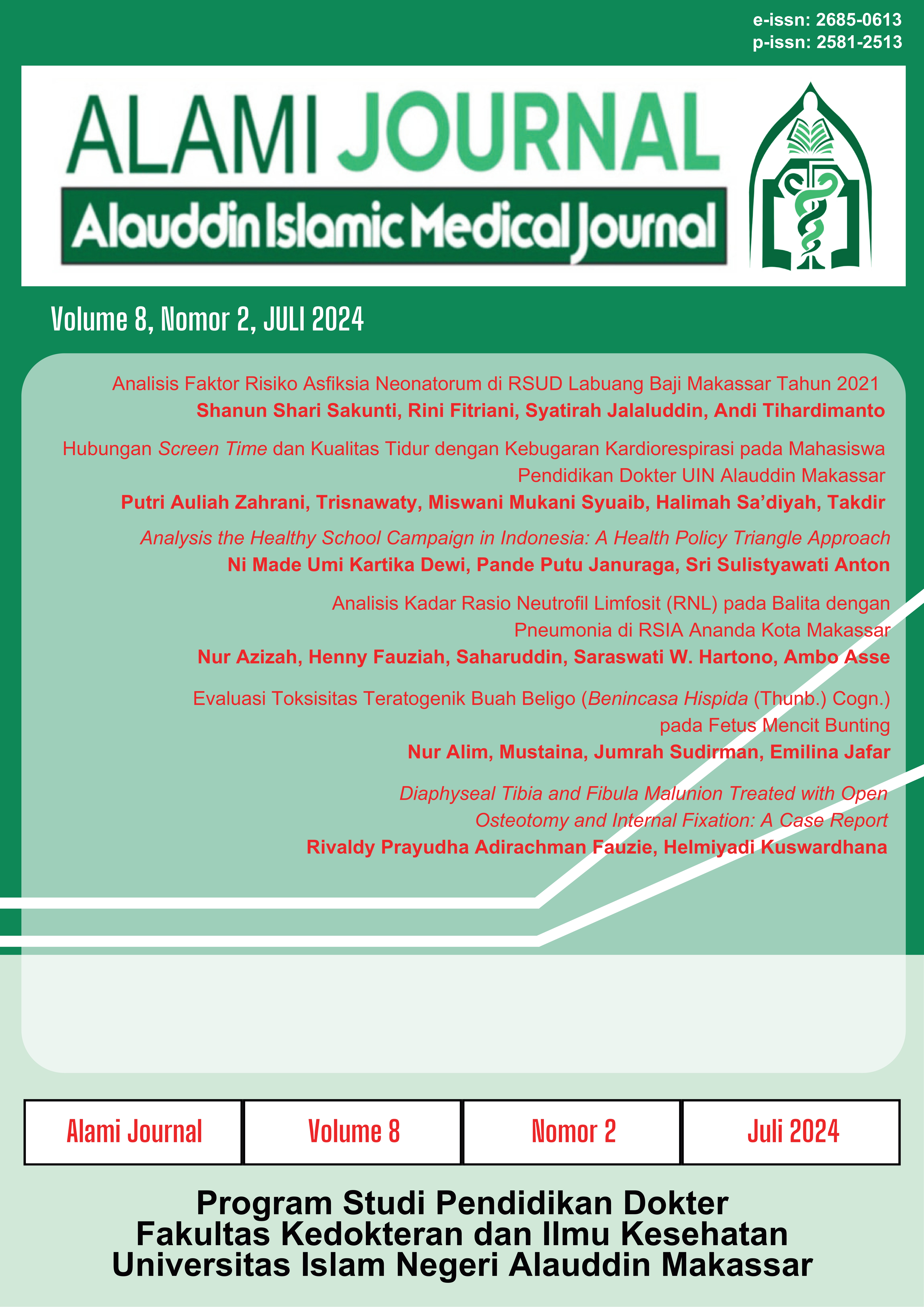Analysis of Risk Factors of Neonatal Asphyxia in Labuang Baji Hospital, Makassar, 2021
Abstract
Analysis of Risk Factors of Neonatal Asphyxia in Labuang Baji Hospital, Makassar, 2021. Asphyxia was the second leading cause of neonatal death in Indonesia in 2019, with 5,464 cases reported. Asphyxia occurs due to inadequate blood flow or gas exchange to or from the fetus in newborns. If not promptly and adequately addressed, this condition can damage vital organs. This study aims to identify the risk factors influencing the incidence of neonatal asphyxia at RSUD Labuang Baji Makassar. The research design employed is an observational analytic approach with a case-control method. Sampling was conducted using purposive sampling techniques with secondary data from patient medical records. The sample consisted of 47 cases and 47 controls, and analysis was performed using chi-square tests and odds ratios. The study found a p-value <0.05 for the association between asphyxia and maternal anemia, premature rupture of membranes (PROM), and low birth weight (LBW), with odds ratios of 3.410, 3.872, 7.451, and 7.765, respectively. The p-value >0.05 indicated no significant association between asphyxia and maternal age, preeclampsia, parity, and mode of delivery. This study concludes that maternal anemia, premature rupture of membranes (PROM), low birth weight (LBW), and gestational age are risk factors for neonatal asphyxia at RSUD Labuang Baji Makassar in 2021.
References
Popoola OT. An Empirical Analysis of Infant Mortality. Journal of Economics and Management Sciences. 2019;2(1):27.
Kemenkes RI. Profil Kesehatan Indonesia 2019. Kementrian Kesehatan Republik Indonesia. 2020. 487 p.
Dinkes Sulsel. Profil Kesehatan Sul-sel 2020. Dinas Kesehatan Provinsi Sulawesi Selatan. 2020.
Dorland. Buku Saku Kedokteran Dorland Edisi 29. EGC; 2015:191.
Newman CGH, Evans RS, Appleyard WJ. Birth Asphyxia. In: NCBI Bookshelf: Startpearls. 2022:1–3.
Syalfina AD, Devy SR. Analisis faktor risiko yang berpengaruh terhadap kejadian. Jurnal Berkala Epidemiologi. 2015;03(03):265–76.
Sadanoer IM, Ayuning Tyas D. Faktor Yang Berhubungan Dengan Kejadian Asfiksia Neonatorum. Jurnal Bidan Komunitas. 2020;111(3):93–8.
Rochmaniah DA, Khofiyah N. Correlation Between Preeclampsia and Preterm Labor with The Incidence of Asphyxia Neonatorum. Pakistan Journal of Medical and Health Sciences. 2021;15(3):1155–8.
Mongdong VAWM, Suryadinata RV, Boengas S, Saroh SA. Studi Faktor Risiko Preeklamsi terhadap Kejadian Asfiksia Neonatorum di RSUD dr. Sayidiman Magetan Tahun 2018. Jurnal Ilmiah Kedokteran Wijaya Kusuma. 2021;10(1):11.
Setiyaningrum E. Buku Ajar Kegawatdaruratan Maternitas Pada Ibu Hamil, Bersalin, Nifas. Yogyakarta: Indomedia Pustaka; 2017:175–8.
Muliawati D, Sutisna E, Retno U. Hubungan Riwayat Hipertensi Dan Paritas Dengan Asfiksia Neonatorum Pada Ibu Bersalin Preeklamsia Berat. Jurnal Kesehatan Madani Medika. 2016;7(1):27–34.
Fajarriyanti IN, Hidayati RW. Faktor – Faktor yang Mempengaruhi Kejadian Asfiksia Neonatorum di RSU PKU Muhammadiyah Bantul Tahun 2016-2017 [disertasi]. Yogyakarta: Universitas Aisyiyah Yogyakarta; 2017.
Widiani NNA, Kurniati DPY, Windiani IGAT. Faktor Risiko Ibu dan Bayi Terhadap Kejadian Asfiksia Neonatorum di Bali: Penelitian Case Control. Public Health and Preventive Medicine Archive. 2016;4(2):95–100.
Sari AK, Tyastuti S. Hubungan Anemia Ibu Hamil Dengan Kejadian Asfiksia Neonatorum Di Rsud Wonosari Gunungkidul Tahun 2015 [disertasi]. Yogyakarta: Poltekkes Kemenkes Yogyakarta. 2017.
Subirah, Ningsih A. Hubungan Anemia pada Ibu Hamil yang Menjalani Persalinan Spontan dengan Angka Kejadian Asfiksia Neonatorum di RSDKIA Pertiwi Kota Makasar Tahun 2017. Global Health Science. 2018;3(2):101–5.
Manuaba I. Ilmu Kebidanan, Penyakit Kandungan, dan KB untuk Pendidikan Bidan. Jakarta: EGC; 2010:319–20.
Wiradharma W, I Md K, I Wyn DA. Risiko Asfiksia pada Ketuban Pecah Dini di RSUP Sanglah. Sari Pediatri. 2016;14(5):316.
Nurdin A, Nurdin H, Rahmayanti, Sari M. Analysis of the relationship between premature rupture of membranes with delivery method and newborn asphyxia. Internasional Journal of Reproduction, Contraception, Obstetrics and Gynecology. 2021 Dec 1;10(12):4377–83.
Bayih WA, Yitbarek GY, Aynalem YA, Abate BB, Tesfaw A, Ayalew MY, et al. Prevalence and associated factors of birth asphyxia among live births at Debre Tabor General Hospital, North Central Ethiopia. BMC pregnancy and childbirth. 2020;20(1):1–12.
Varney H. Buku Ajar Asuhan Kebidanan Vol. 2. EGC; 2008:961–73.
Kusumaningrum RY, Murti B, Prasetya H. Low Birth, Prematurity, and Pre-Eclampsia as Risk Factors of Neonatal Asphyxia. Journal of Maternal and Child Health. 2019;04(01):49–54.
Maryunani A. Asuhan Kegawatdaruratan dan Penyulit pada Neonatus. Jakarta: Trans Info Media; 2009:58.
Tasew H, Zemicheal M, Teklay G, Mariye T, Ayele E. Risk factors of birth asphyxia among newborns in public hospitals of Central Zone, Tigray, Ethiopia 2018. BMC Research Notes. 2018 Jul 20;11(1):1–7.
Jalaluddin S. Transmisi Vertikal Virus Hepatitis B. Universitas Islam Negeri Alauddin Makassar; 2018: 102–103.
Copyright (c) 2024 Shanun Shari Sakunti, Rini Fitriani, Syatirah Jalaluddin, Andi Tihardimanto

This work is licensed under a Creative Commons Attribution-NonCommercial-ShareAlike 4.0 International License.
Once an article was published in the journal, the author(s) are: granted to the journal right licensed under Creative Commons License Attribution that allows others to share the work with an acknowledgement of the work's authorship. permitted to publish their work online in third parties as it can lead wider dissemination of the work. continue to be the copyright owner and allow the journal to publish the article with the CC BY-NC-SA license receiving a DOI (Digital Object Identifier) of the work.


